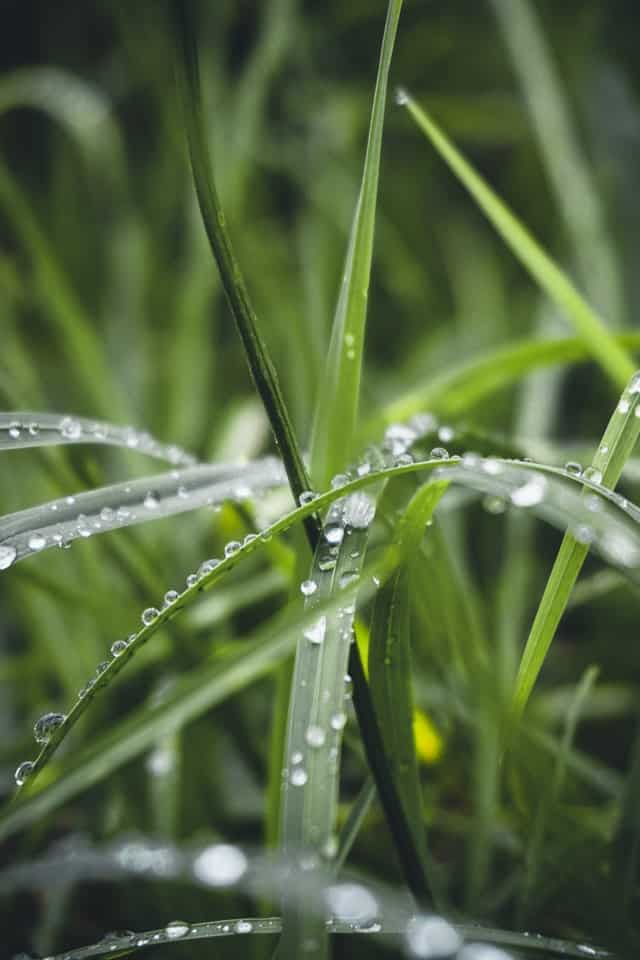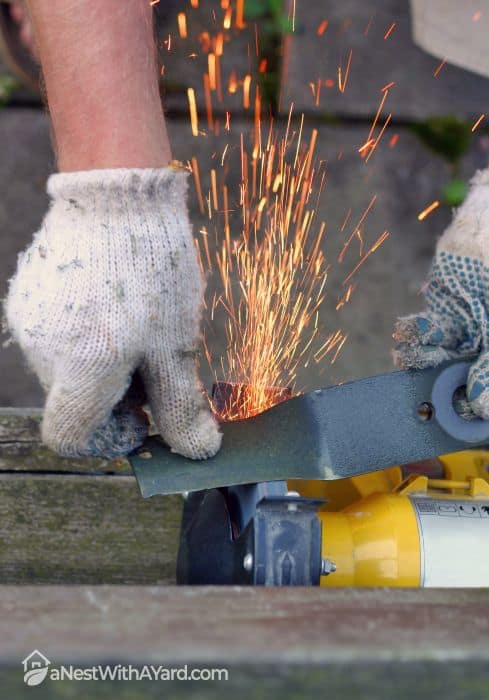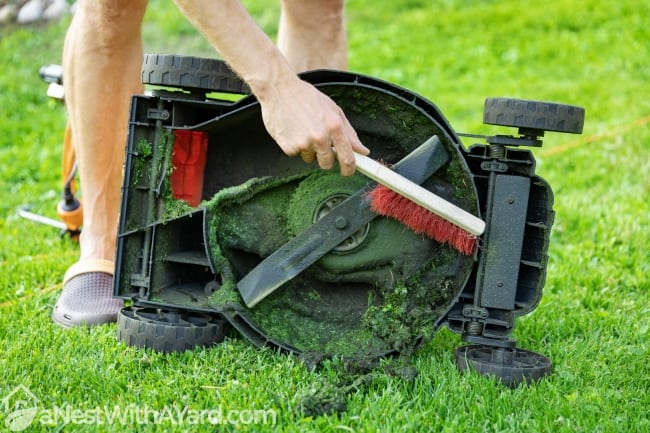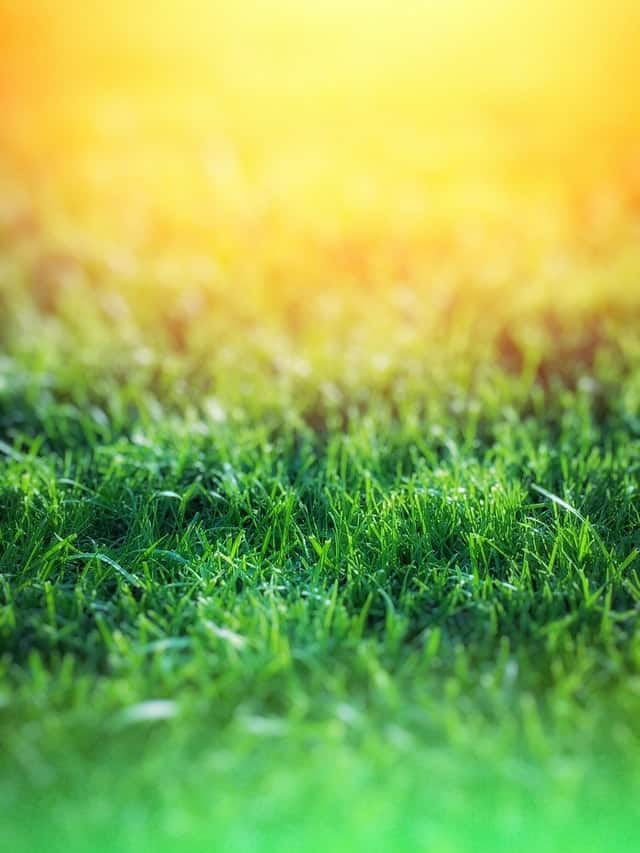The best time to mow the lawn is once the grass has completely dried. This is usually once the sun has passed its peak and the moisture in the grass blades has made its way down into its roots. This protects the grass blades as you mow.
It’s time to mow your lawn but the weather hasn’t held up long enough for the grass to dry. So, do you mow it anyway or hold off until it eventually stops for a good while?
The simple answer is that your grass needs to be dry in order to mow it safely, efficiently and neatly. That’s not to say that it’s impossible to cut grass when it’s wet. It’s just not the safest option – for you or your lawn!
Keep reading to find out everything you need to know about why dry grass is best when mowing your lawn!
Contents
Mowing Wet Grass

Let’s not beat around the bush (literally), but you could be in for quite a rough time if you mow wet grass.
Mowing grass after it rains can be hazardous and cause damage to you, your lawn and even your lawn mower. Wet grass can cause you to slip and fall, your lawn mower will need to work extra hard compared to if it was mowing dry grass, your lawn mower can get rusty and your once healthy lawn could turn into a very patchy, lumpy, sunken one.
For landscaping professionals, unfortunately, mowing wet grass cannot be avoided because they ultimately have a strict schedule that most weather conditions can’t influence.
If you also absolutely need to get the job done and have to mow the grass after it rains, you should follow some crucial safety advice to make sure it’s a safe mowing session. By no means will this give you a perfect-looking lawn, but if you have no other choice but to mow wet grass, this is the best way to do it.

Firstly, please avoid using an electric mower or a riding mower in the rain. The last thing you need is for something like an extension cord or wires to be exposed to water because you’ll run the risk of an electric shock.
It’s best to use a push or gas mower. If you live in a region that received rainfall regularly throughout the year, it’s a good idea to invest in a push mower or a powerful gas mower. If you’re using a gas lawnmower, be careful that excess moisture doesn’t enter the fuel tank because it can contaminate the fuel and cause rust within the tank.
Next, keep in mind that a wet lawn is slippery and you could fall very easily if you’re not careful. So wear sturdy shoes or rubber boots and watch your footing as you make your way through your lawn.
To avoid an untidy-looking lawn, you need to keep your lawn mower blades sharp. Using blunt blades will give you an uneven cut because wet grass tends to bend easily and tear. If your lawn receives an uneven cut, you’ll end up with grass blades of slightly different heights once your lawn is dry.

Torn grass blades will open up a whole other can of worms for you because they put your lawn more at risk of contracting diseases and fungi.
Remember that wet grass clippings clump together. This makes it easier for them to clog up your lawn mower and get stuck in crevices around the mower blades and the mower deck. The grass clippings that fall onto the lawn are generally thicker than dry grass and will block out any sunlight, thereby killing the grass beneath them.
If you’re giving your wet lawn a go, you’re going to need to use some extra muscle. Wet grass is generally a lot heavier than dry grass and your lawn mower will need to work harder to get the job done. However, if you have a professional-grade lawn mower, it should be able to manage a heavier load.
Check out this great video by YouTube user The Lawn Care Nut for more information on how to cut wet grass:
Once you finish mowing your lawn, make sure you clean the mower thoroughly and brush out the mower deck to get rid of any grass cuttings and grass clumps that may have gotten stuck. You should also avoid interfering with your lawn for at least 24 hours after mowing so that it has a chance to recover while improving overall health and appearance.

How wet is too wet? It’s not preferable to cut wet grass, but it is okay under extreme circumstances. The deciding factor here is just how wet your lawn is. If you step on your lawn and your shoes soak through or you sink into the soil, it’s too wet and you should not mow it until it dries up.
If your grass is just too wet to even think about bringing your mower out and you desperately need to mow your lawn, it might be a good idea to use some DIY methods to speed up the drying process. Check out this article for quick and easy ways to dry out a wet lawn.
Waiting For Wet Grass To Dry Up

The best time to mow your lawn is when your grass is completely dry. But, depending on where you live, sometimes this is just not practical or even possible.
To spot dry grass, check to see whether you can notice a difference in form of the grass blade. See whether they’re bent or whether they stand tall. Wet grass will droop a little due to the weight of the water but dry grass will stand straight up. If it hasn’t rained a lot or very heavily, you can use your pavement as a guide. Your grass should be dry if your pavement is.
How long you should ideally wait for the grass to dry before mowing depends on a couple of factors, such as:
- What season you’re in (grass will dry faster in summer compared to spring, autumn and winter)
- The volume of rainfall received
- How much sunlight you’ve received
Mowing Grass Before It Rains

If the weatherman drops a friendly warning of rain incoming, it’s not a bad idea to whip out your lawnmower and mow the grass before it rains.
When you mow grass, the grass blades tend to experience stress. When they’re showered with rainfall, it’s easier for them to recover from the mowing action. Another benefit of this is that the rain will essentially push down the grass clippings and help break them up.
While dry grass is best, you also need to keep in mind that mowing grass that is too dry could cause just as much damage as mowing wet grass. So, it’s best to avoid mowing grass in the midst of a heatwave or during the hottest part of the day as the grass will get highly stressed and will suffer from heat exhaustion.
N.B. Remember that if you’re applying a herbicide like Weed and Feed to your lawn, you need to mow the grass before applying it. In this case, mowing is advised if your grass is too tall and surpasses 5 inches. The important thing to remember here is that if you do end up needing to mow your lawn before applying the herbicide, you’ll need to wait at least 2 days before continuing with the application process.
How Often Should You Cut Grass?

The frequency of lawn mowing depends on the types of grasses in your yard, how fast they grow and what season you’re in. Most grass types require mowing roughly once a week in spring and twice a week in summer. This is because grass will typically grow faster in a warmer season compared to spring.
For best results, you should wait for your grass to reach 3 inches high before mowing. Longer grass blades encourage deeper grass roots and help shade the soil. This will promote your lawn’s health. Remember to not cut your grass too short because super short grass can turn yellow and brown during a hot summer.
Mid-morning and late afternoon are the best times to mow your lawn. Late afternoon is a great time because once the sun has passed its peak, most of the moisture in the grass would have been absorbed into the grass roots. This will protect and strengthen the grass while you mow. You shouldn’t cut grass in the early morning because there’s usually a lot of moisture at that time of the day due to morning dew.
Check out this informative video by YouTube user Ryan Knorr Lawn Care for more detail on when is the best time for lawn care:
FAQs
Should You Mow Your Lawn Before Rain?
You should mow your lawn before rain. This is because the best time to cut grass is when it’s dry. It is harder to mow a wet lawn compared to a dry lawn because very wet grass can cause you to fall, your lawnmower to malfunction and uneven cutting.
Should You Mow The Lawn After It Rains?
You should not mow the lawn after it rains. You should ideally wait for it to dry a little before mowing. Wet grass clippings can cause harm to your lawnmower when they get stuck in and around the blades and to your lawn if the weight smothers it.
Does Grass Grow Faster In Rain?
Grass does grow faster in rain. Grass growth is accelerated because once the rain has soaked into the soil, it activates the microbes and releases nitrogen. The rainwater allows the roots to absorb both the newly released nitrogen and the nitrogen that was previously released.
Now You Know When To Mow Your Lawn
That’s a wrap! When you take pride in your lawn care, it can be quite concerning to think that a simple act of cutting grass at the wrong time could lead to some major damage to your lawn.
If you’ve been wondering about whether you’ve been cutting grass at the wrong time, I hope this article has helped you figure out the reasoning behind why mowing before or after rain makes such a big difference.
If you found this article helpful, please feel free to leave me a comment below and share this with a friend.

